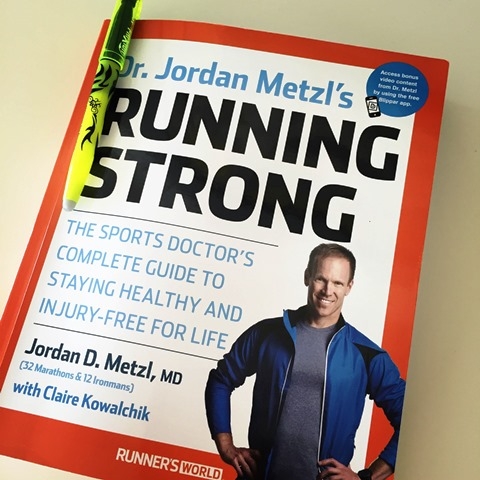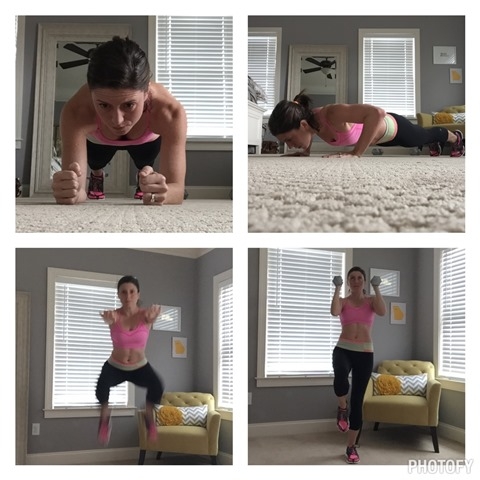Secrets and Practical Solutions for Running Strong
As a runner and a coach, I would be a millionaire if I had a dollar for every time another runner – new or a seasoned veteran – told me they were experiencing an overuse injury or pain. My hip hurts. My knee hurts. My calves hurt. My foot hurts.
When I ask people about their running patterns leading up to these nagging aches and pains and what they’ve been doing about it, very few cite strength training as a regular part of their training and injury prevention strategy. And yet, strength training is a huge key to running healthy and strong for life.
That’s the topic in Dr. Jordan Metzl’s latest book Running Strong. My friends at Runner’s World were kind enough to send me an advanced copy before it was on the shelves earlier this year. I devoured this book in two days, and it has become my running bible since the moment I opened it weeks ago.

For most runners, I think strength training is a mystery that can feel overwhelming or intimidating. Many runners aren’t sure what to do, when to do it or how often. We know enough to be dangerous but don’t often put exercises, sets and reps together in such a way to enhance our running performance. Furthermore, strength training is typically the first thing most of us cast aside when our weeks get busy and we have to pick and choose what workouts get squeezed into our schedules.
Does this sound familiar???
Running Strong suggests that’s a huge mistake. The book offers practical guidance, advice and solutions to help us all run happier and healthier.
Dr. Metzl is a seasoned athlete himself (having completed 32 marathons and 12 Ironmans) and has also gone through a traumatic injury (torn ACL) and come back even stronger and faster. He gets it. He gets runners. And he speaks from solid experience as an athlete and a medical doctor. Here are a few things I particularly like about Running Strong:
- Dr. Metzl provides advice he would give to his patients on a variety of common running-related aches and pains in the feet and ankles, legs, knees, hips, groin, glutes, back and upper body. He describes symptoms in detail and shares what you should do if you are encountering such pain. In most cases, his guidance will help you diagnose what may be wrong and in many instances, save you a trip to the sports medicine doc along with a course of action to fix it on your own.
- There are detailed stretches and strength training provided for both injury-prevention and recovery for each key area of concern, with drawings and step-by-step guidance. No matter what part of your body causes you trouble, you’ll have a good regimen of stretches and exercises you can do daily to help you.
- The IronStrength workout Dr. Metzl shares is amazing. It consists of about a 45-minute strength training session that can be done in your own living room with a single set of dumbbells. More about this in a minute.
In sharing some photos and thoughts during the past few weeks on social media about the book and my experience with the IronStrength workout, Dr. Metzl (@drjordanmetzl) has responded to me every time with encouragement or additional advice. That makes me like him and the book even more (if that is actually possible).
Here are a few additional lessons I took away from Running Strong and Dr. Metzl’s philosophies:
- Exercise every day, including rest days. Metzl believes that physical activity is the best medicine for every ailment (for the mind and body). He believes that rest and recovery is critical, but encourages 30-minute slow runs or cross training like yoga for an easy/recovery day.
- When pain changes the way you run, that’s when it’s time to stop. I’m not always 100 percent certain when I and others should run through pain, take time off, go to the doctor, etc. I tend to err on the conservative side and stop or rest. Dr. Metzl clarified this beautifully in his book by suggesting that the minute pain changes your running form is when you need to stop and go see your doctor. Changes in form can alter other issues and create additional imbalances where your body overcompensates. If your form doesn’t change, you can keep running; but the minute it does, it’s time to call the doc.
- Keep exercising when you’re injured. Yes, you heard that right. Dr. Metzl is a fan of dynamic rest – meaning doing activities in which you feel no pain but allow you to stay active. This may mean the elliptical, strength training or some other activity that does not aggravate your injury, and strength training can even help speed recovery.
- You can prevent and control pain with strength. Incorporating strength training two to three times a week with exercises that mimic movements you do in real life (functional strength training) can help prevent muscle imbalances that often lead to injury. The IronStrength workout offered in the book is a great way to get this in.
- A strong butt = a happy life. Our butt is our strongest muscle in our body and generates most of the force when we run. Dr. Metzl shares how weak glutes can lead to a variety of injuries and that by strengthening your booty, your troubles will often disappear. You’ll hear him say this a lot throughout the book. Even more incentive to have a “nice ass.”
- Don’t forget the small stuff. Metzl encourages monthly or twice-monthly massage, getting 7-8 hours of sleep each night, foam rolling daily, fueling your body well and making sure you’re having fun. These are small details of our daily training that add up to make a big impact.
Perhaps my favorite part of Running Strong is the IronStrength workout featured. It consists of a short warm-up followed by seven sets of exercises and concludes with stretching and rolling. It is very challenging and I have been quite sore after the workout. I use 10-pound dumbbells. My goal is to do this at least once per week along with other strength training I do through my cross-training.

All in all, I give Running Strong five stars and two thumbs up. This is a book that needs to be on every runner’s bookshelf, and more importantly, it contains critical guidance and action items that we should actively be doing daily. Your body and your running performance will thank you.
Have you read Running Strong yet? If so, what did you think? How do you integrate strength training into your weekly training regimen?



Comments
I am one to admit that my strength training regiment completely falls to the side when I start a race training plan. I was diligent over the winter with incorporating core strength workouts, but have not done one since I started training for my upcoming 70.3. I have heard numerous positive comments about this book, so it might be a purchase to consider! Thanks for sharing your thoughts!
Let me know what you think if you read it Lee! Good luck with your remaining 70.3 training!!!
i’ll have to get this book. strength/cross-training has really helped me become a faster, injury-free runner but i’m in need of a new strength routine. thanks!
I think you will like this workout, Mary. I really love it and it is super challenging. You will probably be sore the first few times 🙂 Happy running! xoxo
Sounds like a great read! My strength traing is primarily functional, body weight exercises. I find I do run so much stronger when I am intentional in my strength training routine.
Great article! “I have a lot of pain in my shins, each time I engage in a physical activity such as running, it feels like knives are running through my shins. What is wrong with the shins (muscle, bone or tissue?) when you have shin splints?” A lot of people asked me this question for almost 10 years. I started a blog for that people, I helped them to defeat forever their shin pain. It’s only a matter of knowledge: if you know what is the primary cause, it is easier to know what is wrong with your shins. If you want to find out how your shin splints actually cause so many problems in the foot and ankle stay check my blog!
Thank you for sharing your blog and experience Gary! I love your blog name and I look forward to checking out your insights! Thanks for stopping by! Happy running!
I came across this the other day online, but wasn’t sure. Now that I read your review I feel like I have to get it and try it. I like integrating strength in my training and feel it’s helped me over the years but could use a good read on it all to keep it fresh, and hopefully learn new stuff!
Great timing as my new goal during this marathon cycle is to add strength training. Thank you for the additional encouragement!
Wow!
I must get this book. I really need more strength training and I love a workout that I can do in my living room.
Great article again.
Thanks, thanks, thanks!
I am a collegiate runner and I thought that I was pretty strong when it came to cross training… I don’t know what I was thinking, I ordered this book and DVD after reading your review and I just did the iron strength workout for the first time and I’m so gonna be sore tomorrow! Thanks for the post!
I’m so glad you liked the workout Danielle! I hope your soreness doesn’t stick around too long. I’ve been trying to do the workout at least once a week, and my glutes are always a little sore after. xoxo
or these exercises in the book and do they have photos on ho wto do them corectly.
Yes. The book is fantastic. All the exercises are explained in the book with pictures. Let me know what you think if you try it. Happy running!